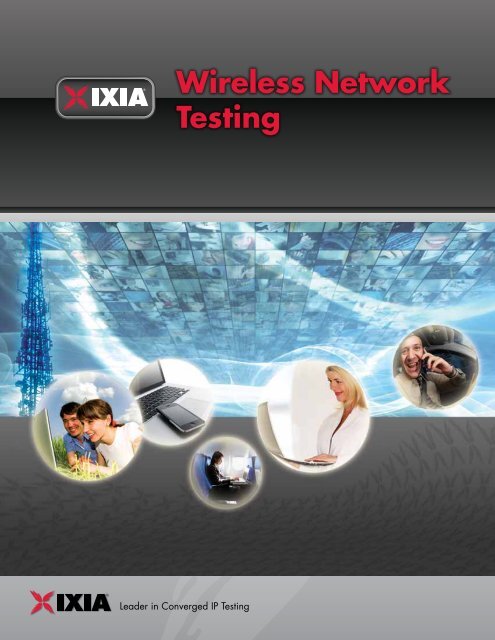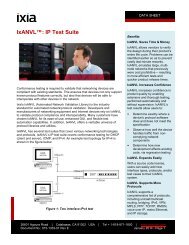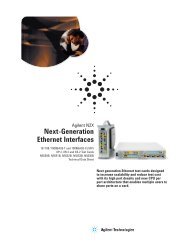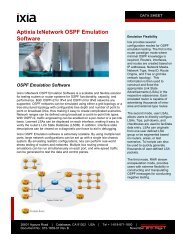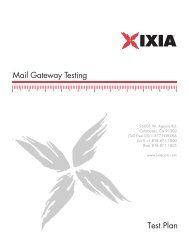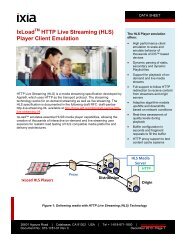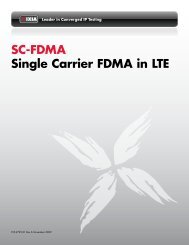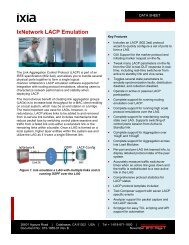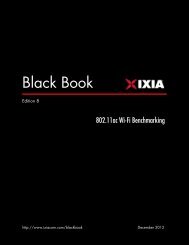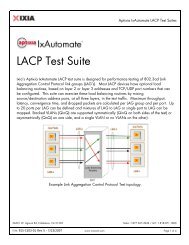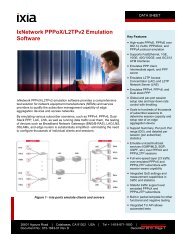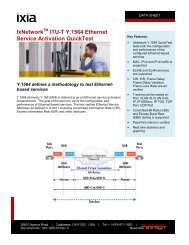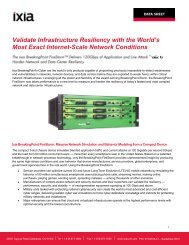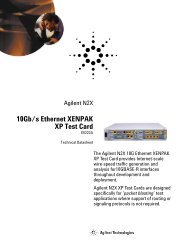Wireless Network Testing - Ixia
Wireless Network Testing - Ixia
Wireless Network Testing - Ixia
You also want an ePaper? Increase the reach of your titles
YUMPU automatically turns print PDFs into web optimized ePapers that Google loves.
<strong>Wireless</strong> <strong>Network</strong><br />
<strong>Testing</strong><br />
Leader in Converged IP <strong>Testing</strong><br />
1Q09
The Progression of<br />
<strong>Wireless</strong> Technologies<br />
Cellular data speeds, beginning with GPRS in 1999, have<br />
increased over the last decade by a factor of 10 every 3-5<br />
years. This growth has been driven by increased consumer<br />
demand for wireless data bandwidth. Reporterlink 1 has<br />
estimated that wireless data traffic will increase ten-fold<br />
between 2009 and 2017 – a 59% CAGR. Data traffic is<br />
expected to hit 1.8 exabytes/month 2 , fueled by a rapid<br />
increase in interactive data and multiplay applications.<br />
Video is the largest bandwidth consumer today, a fact that<br />
will continue for the foreseeable future.<br />
LTE<br />
Long Term Evolution (LTE), as defined by the Third<br />
Generation Partnership Project (3GPP), is widely<br />
acknowledged as the next generation technology for both<br />
voice and data wireless transmission. LTE was first specified<br />
in the 3GPP Release 8 specification in December, 2008.<br />
With the exception of the air interface, LTE is an all-IP<br />
network – taking advantage of and converging with IP<br />
network technology. LTE has some impressive capabilities:<br />
1 Reporterlink, 9/09<br />
2 An Exabyte is 10 18 - a billion, billion<br />
2<br />
1000 Mbps<br />
100 Mbps<br />
10 Mbps<br />
1 Mbps<br />
100 Kbps<br />
10 Kbps<br />
GPRS<br />
CDMA<br />
EDGE<br />
CDMA 2000<br />
1xEVDO<br />
UMTS<br />
• Support for multiple-input, multiple-output (MIMO)<br />
antenna technology, including 2x2 and 4x4<br />
configurations.<br />
• 300 Mbps downlink and 150 Mbps uplink bandwidth<br />
when using 4x4 MIMO.<br />
• Latencies of less than 5 ms.<br />
• Hundreds of users per cell.<br />
Most major telecom equipment manufacturers (TEMs) and<br />
carriers have announced their intention to develop and<br />
provide LTE products and services. As of early 2010, 51<br />
providers in 24 countries have made commitments 3 . Early<br />
deployments are expected in Asia and North America in<br />
2010, with significant expansions in all major markets in<br />
2012. 2013 will see some 85 million LTE subscribers 4 and<br />
nearly half a billion people will use LTE by 2015. 5<br />
HSDPA<br />
1xEVDO(A)<br />
TODAY<br />
1999 2000 2001 2002 2003 2004 2005 2006 2007 2008 2009 2010 2011 2012<br />
Figure 1. <strong>Wireless</strong> Bandwidth Trends<br />
1xEVDO(B)<br />
HSPA+<br />
WiMax<br />
The strategic LTE components consist of a new radio<br />
standard and the eNode B, which supports the LTE air<br />
interface and performs radio resource management.<br />
The eNode B integrates the functions of the 3G node B<br />
and RNC, making the eNode B a complex element and<br />
flattening the network architecture.<br />
Alongside LTE development is the evolution of the core<br />
architecture, called the evolved packet core (EPC), which<br />
maximizes data throughput while minimizing latency and<br />
network complexity.<br />
3 Global mobile Suppliers Association (GSA)<br />
4 Forward Concepts<br />
5 Analysys Mason<br />
LTE<br />
LTE Advanced
The key functional elements of the EPC include:<br />
Mobility Management Entity (MME) – The MME has<br />
a key role in the EPC in the handling of mobile users. It<br />
performs the signaling and control functions that manage<br />
the mobile users’ access to LTE, assigns network resources,<br />
and manages mobility states that support roaming, paging,<br />
and handovers. The MME oversees all control plane<br />
functions related to subscriber and session management.<br />
Serving Gateway (SGW) – the SGW is a node that<br />
provides data paths between eNode Bs and the PDN-GW.<br />
The essential capabilities of the SGW, aside from routing<br />
and forwarding packets, is that it acts as a local mobility<br />
anchor point for inter-eNode B handovers as well as<br />
managing mobility between LTE and 2G/GSM and 3G/<br />
UMTS networks. The SGW also provides charging services<br />
for user equipment, the PDN, and service classes.<br />
Millions<br />
80<br />
70<br />
60<br />
50<br />
40<br />
30<br />
20<br />
10<br />
0<br />
Packet Data <strong>Network</strong> Gateway (PDN-GW) –<br />
The PDN-GW is the termination point of the packet data<br />
interface connecting to packet data networks, providing the<br />
anchoring function for sessions with external networks. A<br />
critical function of the PDN-GW is the ability to enforce peruser<br />
packet filtering, allowing gating and rate enforcement<br />
policies as well as service level charging.<br />
The EPC is the all IP-mobile core network for LTE, allowing<br />
the convergence of packet-based real-time and non-real-time<br />
services. These elements, along with radio and network<br />
technology from earlier wireless technologies, are shown in<br />
Figure 3.<br />
CY08 CY09 CY10 CY11 CY12 CY13<br />
EMEA North America Asia Pacific CALA<br />
Figure 2. Worldwide LTE Equipment Revenue Forecast 5<br />
3
Other <strong>Wireless</strong> Technologies<br />
As with existing deployments, LTE networks need to<br />
interoperate with a variety of existing wireless edge and<br />
core technologies. Principal among these are Universal<br />
Mobile Telecommunications System (UMTS) and IP<br />
Multimedia Subsystem (IMS).<br />
UMTS, which uses W-CDMA as the underlying air interface,<br />
is one of the 3G mobile telecommunications technologies.<br />
UMTS also covers the core radio access network (UTRAN).<br />
Two common technologies associated with UMTS are high<br />
speed downlink packet access (HSDPA) and high speed<br />
uplink packet access (HSUPA), together referred to as HSPA<br />
and sometimes called 3.5G. HSPA+ is a further evolution<br />
of HSPA that uses the same equipment. HSPA+ networks<br />
can expect a downlink transfer rate of up to 44 Mbps when<br />
using HSDPA+ handsets. As of 2010, over 300 networks<br />
in 142 countries offer HSPA; a total of 66 operators have<br />
committed to HSPA+. 6<br />
IMS is an architectural framework for delivering IP<br />
multimedia to fixed and mobile users. IMS facilitates the<br />
blending of triple-play in interactive, personalized ways.<br />
Delivery of a triple-play bundle is a highly desirable<br />
6 Global Mobile Suppliers Association (GSA)<br />
4<br />
Control Plane<br />
User Plane<br />
LTE<br />
3G<br />
2G<br />
Radio Access <strong>Network</strong> Evolved P<br />
node B<br />
BTS<br />
RNC<br />
BSC<br />
Control User Plane<br />
objective for service providers of all types. IMS creates a<br />
network where new applications can be plugged in like<br />
Lego blocks. More competition is fostered, allowing<br />
operators to choose the most cost-effective equipment for<br />
each function.<br />
<strong>Wireless</strong> Core and<br />
Internet Core <strong>Network</strong>s<br />
MME<br />
SGSN<br />
Increased usage of HSPA+ and LTE networks will place<br />
increased bandwidth requirements on wireless core and<br />
Internet core networks. As more people simultaneously use<br />
multiple wireless technologies, the complexity of the core<br />
networking control plane signalling and the volume of<br />
bearer traffic will rise. The data requirements associated<br />
with multiplay applications will have two dramatic effects<br />
on the core networks: a need for increased capacity and a<br />
need for more intelligence. <strong>Wireless</strong> frequency bandwidth<br />
is an inherently limited resource. That bandwidth must be<br />
carefully balanced to provide all users with an acceptable<br />
quality of experience (QoE). Techniques such as deep<br />
packet inspection (DPI) must be used to properly identify<br />
information flows so as to provide them with the proper<br />
QoS.<br />
S<br />
HSS A<br />
Figure 3. End-to-End Wirele
acket Core Packet Data <strong>Network</strong><br />
GW PDN-GW<br />
AA PCRF<br />
ss <strong>Network</strong> Components<br />
<strong>Wireless</strong> <strong>Testing</strong><br />
Requirements<br />
The major components of an end-to-end wireless network<br />
solution are shown in Figure 3. Complete testing of a<br />
wireless service must separately test the components in each<br />
of the radio access network, wireless core network and<br />
Internet core networks, test each of the three subsystems<br />
independently, and test the entire system end-to-end, from<br />
the wireless edge through the Internet core.<br />
Proper testing occurs at multiple levels, usually in a<br />
sequential manner:<br />
• Compliance testing is an essential first step in<br />
ensuring correct operation and interoperability.<br />
Compliance tests are built from RFC and other<br />
standards, and are designed to perform positive and<br />
negative tests that ensure devices properly implement<br />
the standards.<br />
Internet<br />
IMS and Operator Services<br />
• Functional testing further exercises device<br />
capabilities with combinations of options, multiple<br />
connections, differing types of traffic, and many<br />
sequences of operations. Full protocol stacks are tested<br />
at this level, along with further negative tests.<br />
• Performance testing measures raw capacity, such<br />
as the maximum number of connections, maximum rate<br />
of connection establishment, and maximum uplink and<br />
downlink throughput.<br />
• Scalability testing measures real-world effectiveness<br />
and the ability to handle a complete user community.<br />
This type of testing requires realistic traffic loads that<br />
meet and exceed network capacity, coupled with<br />
quality of experience measurements.<br />
5
LTE <strong>Testing</strong><br />
<strong>Testing</strong> of LTE components and networks is especially<br />
challenging due to their complexity and operational scale.<br />
Radio Access <strong>Network</strong> (eNode B)<br />
The eNode B is the key element of the LTE radio access<br />
network, as shown in Figure 3. It is the most complex part<br />
of the LTE access network, and is more complex than the<br />
UMTS node B or GSM base transceiver station (BTS) since<br />
it operates without a controller (RNC – radio network<br />
controller or BSC – base station controller). The functions<br />
of the central controller are performed by the eNode B,<br />
making it a critical component of the new LTE network<br />
architecture.<br />
The complexity of the eNode B is manifest in its complete<br />
stack implementations. The Uu interface, shown in Figure 4,<br />
embodies a number of previously distributed protocols. It is<br />
essential that testing explore all stack layers, not merely the<br />
top layers.<br />
6<br />
NAS<br />
RRC<br />
PDCP<br />
RLC<br />
MAC<br />
PHY<br />
User Script<br />
UDP|TCP/IP<br />
CPRI Radio<br />
Figure 4. Uu Interface Stack<br />
Radio access testing for earlier wireless generations was<br />
often accomplished through the use of banks of modified<br />
handsets. The scale of modern eNode Bs makes this<br />
approach no longer viable. Similarly, low to moderate<br />
bandwidth testing used in earlier technologies cannot be<br />
used to stress a network that will transport 300 Gbps of<br />
download traffic.<br />
Both network and air interfaces must be simulated to fully<br />
test the eNode B. Coordinated testing using Uu, X2 and<br />
S1 interfaces is required – emulating the operation of other<br />
eNode Bs, MMEs and SGWs. Many eNode B functions<br />
and procedures can only be verified through emulation<br />
of all surrounding components. For example, signaling<br />
between the user equipment (UE) and eNode B on the Uu<br />
interface is tightly coupled with intra-E-UTRAN signaling<br />
on the X2 interface and signaling between the eNode B<br />
and the EPC on the S1 interface. This tight coupling<br />
makes testing any one interface in isolation difficult, if not<br />
impossible. <strong>Testing</strong> through all of the eNode B’s interfaces<br />
verifies all eNode B user plane connections by:<br />
• Applying a variety of realistic user plane traffic flows.<br />
• Coordinating each user plane flow according to the<br />
signaling exchanged with the eNode B.<br />
• Verifying the content of user plane traffic flows<br />
transmitted by the eNode B.<br />
• Exercising control of user plane frames at both the<br />
source and sink.<br />
• Measuring the QoE delivered for each traffic flow.
Evolved Packet Core (EPC)<br />
The EPC components – MME, SGW, and PDN-GW –<br />
together with the eNode B handle user mobility, unique<br />
bandwidth, and quality requirements of multiplay<br />
applications and error situations. <strong>Testing</strong> of these<br />
components must use multiple connection scenarios and<br />
real-world combinations of voice, video, and data traffic<br />
to ensure proper, scaled operation. EPC-specific testing<br />
challenges include:<br />
• Capacity and performance – with thousands<br />
of eNode Bs, potentially carrying from 1 to 300<br />
Gbps of traffic each, the capacity in the EPC could<br />
quickly become an issue in terms of high availability,<br />
validation, and network configuration.<br />
• Media – a typical LTE mobile user will concurrently run<br />
many types of applications, including voice, texting,<br />
video viewing, and e-mail updates. Real-world traffic<br />
is required to fully validate QoE enforcement and the<br />
effect of gating and policy control on the network.<br />
• Quality of service – expressed in jitter, latency,<br />
packets dropped, and other measurements are key<br />
performance indicators in an all-IP network.<br />
• Interoperability with 2G/3G networks – LTE will<br />
likely be deployed in small islands in a sea of existing<br />
2G/3G networks.<br />
node B<br />
UTRAN<br />
lub<br />
lub<br />
lub<br />
RNC<br />
RNC<br />
RNC<br />
iu-CS<br />
iu-CS<br />
lu-PS<br />
• Multiple architectures – MMEs, SGWs, and PDN-<br />
GWs may be combined into single hardware units.<br />
Different combinations and network structures are<br />
possible.<br />
• End-to-end data and control plane security –<br />
IPSec, TLS, and other security is required in some EPC<br />
components and optional in others.<br />
As with eNode B testing, coordination of control and user<br />
plane traffic from all interfaces is essential, utilizing the<br />
S11, S1, S8 and S5 interfaces that emulate eNode B,<br />
MME, SGW, and PDN-GW operation. With different<br />
combinations of these interfaces it is possible to test the<br />
functionality, performance, and scale of the MME, SGW,<br />
and PDN-GW.<br />
UMTS<br />
<strong>Wireless</strong> providers have invested heavily in UMTS/HSPA/<br />
HSPA+ technology, and will push their deployment in favor<br />
of LTE for several years. The testing of these components<br />
and sub-systems requires the same types of techniques used<br />
in LTE testing: coordinated use of all individual device and<br />
sub-system interfaces. As shown in Figure 5, the essential<br />
HSPA components are the node B, RNC, serving GPRS<br />
support node (SGSN), and mobile service switching center<br />
(MSC), using lub, lu-CS, and lu-PS interfaces.<br />
Though not as much as with LTE, HSPA+ still requires a<br />
significant amount of multiplay data traffic to measure<br />
capacity – up to 44 Mbps on the download link and 11<br />
Mbps on the upload link.<br />
MSC<br />
Server<br />
Mc<br />
MGW<br />
SGSN<br />
Figure 5. UMTS Edge and Core <strong>Network</strong><br />
Core <strong>Network</strong><br />
Nc<br />
Nb<br />
Gn<br />
GMSC<br />
Server<br />
Mc<br />
MGW<br />
GGSN<br />
7
IMS<br />
IMS promises to be a key component of LTE deployments<br />
– serving as the unifying mechanism for delivering voice<br />
and other services. As shown in Figure 6, IMS is a complex<br />
system encompassing many possible components that<br />
are linked by multiple protocols. Several base protocols,<br />
especially session initiation protocol (SIP), are being<br />
extended to support IMS functionality. As shown in Figure<br />
6, testing can be performed for the major categories:<br />
• Core <strong>Network</strong> – using protocols for testing call<br />
session control functions in the P-CSCF, interrogating<br />
CSCF (I-CSCF), and serving CSCF (S-CSCF).<br />
8<br />
Application Servers<br />
Application<br />
Server HSS<br />
PCRF<br />
P-CSCF<br />
Access <strong>Network</strong><br />
(3GPP, DOCSIS,<br />
3GPP2)<br />
Core <strong>Network</strong><br />
I-CSCF<br />
MGCF<br />
IM-MGW<br />
Interworking Elements<br />
Figure 6. IMS <strong>Network</strong> Components<br />
• Interworking Elements – using protocols for media<br />
and signaling gateways in the IP multimedia media<br />
gateway (IM-MGW), signaling gateway (SGW), media<br />
gateway controller function (MGCF), and breakout<br />
gateway control function (BGCF).<br />
• Application Servers – using protocols, including SIP,<br />
for application servers, home subscriber service (HSS),<br />
and subscriber location function (SLF).<br />
Service providers will continue to support multiple wireless<br />
technologies. It is essential that the wireless core network be<br />
tested under conditions in which UEs from different sources<br />
share the network – and that their relative quality and<br />
bandwidth requirements be met.<br />
S-CSCF<br />
BGCF<br />
SGW<br />
SLF<br />
MRFC<br />
MRFP<br />
IP<br />
<strong>Network</strong><br />
CS<br />
<strong>Network</strong>
<strong>Ixia</strong> Test Solutions<br />
<strong>Ixia</strong> provides a complete set of test solutions for use in<br />
wireless testing. <strong>Ixia</strong>’s test solutions are end-to-end from the<br />
wireless edge to the Internet core. <strong>Ixia</strong>’s platforms and test<br />
applications, including IxCatapult, IxLoad, Ix<strong>Network</strong>, and<br />
IxANVL are used to test individual devices, subsystems or<br />
entire networks.<br />
LTE <strong>Network</strong> <strong>Testing</strong><br />
<strong>Ixia</strong> tests LTE radio access and EPC network components<br />
both independently and in combination.<br />
eNode B <strong>Testing</strong><br />
Figure 7 depicts the emulation environment used to test<br />
eNode B elements.<br />
<strong>Ixia</strong>’s physical network interfaces emulate all of the<br />
components that surround an eNode B in a live network:<br />
• UEs connected through Uu radio interfaces.<br />
• Other eNode Bs to model mobility situations, using the<br />
X2 interface.<br />
• Serving gateways over the S1-U interface.<br />
• Mobility management entities over the S1-MME<br />
interface.<br />
User<br />
Equipment<br />
Emulation<br />
Device<br />
Under<br />
Test<br />
<strong>Ixia</strong>’s UE emulation includes:<br />
• Multi-UE emulation. Hundreds of emulated users<br />
per sector, with 6-sector support test any eNode B at its<br />
maximum capacity and complexity. With 2x2 MIMO,<br />
up to 125 Mbps of download traffic can be generated<br />
and verified.<br />
• Full Uu interface support with associated<br />
protocols. PHY, MAC, RLC, PDCP, RRD and NAS<br />
protocols through available encoders and decoders,<br />
state machines and procedure libraries.<br />
• Uu simulation. Includes support for 5, 10 and 20<br />
MHz channels, 2x2 MIMO, in-cable CPRI v3.0/4.0,<br />
and RF over LTE frequency bands I-XIV.<br />
• Simulation of real-world scenarios. Register and<br />
de-register, handover with inter-eNode B, intra-eNode<br />
B and IRAT, as well as interoperability with UTRAN,<br />
GERAN, CDMA2000 and IMS.<br />
The content of the user plane traffic flows sent by the<br />
eNode B is verified with a variety of realistic user plane<br />
traffic flows, while coordinating each user plane flow with<br />
the signaling.<br />
X2<br />
eNode B<br />
Emulation<br />
Figure 7. eNode B <strong>Testing</strong><br />
S1-u<br />
S1-c<br />
SGW<br />
Emulation<br />
MME<br />
Emulation<br />
9
SGW<br />
Emulation<br />
eNode B<br />
Emulation<br />
Evolved Packet Core<br />
The three key devices in the EPC – the MME, SGW,<br />
and PDN-GW – are similarly tested by emulating all<br />
interconnected devices. The emulated interfaces include:<br />
• MME – S1-C, S3, S10, S11, and S6a interfaces<br />
are used to emulate other MMEs, eNode Bs, SGWs,<br />
SGSNs, and HSS.<br />
• SGW – S1-U, S4/S12, S5/S8, Gxc, and S11<br />
interfaces are used to emulate eNode Bs, MMEs,<br />
SGSNs, PDN-GWs, and PCRFs.<br />
• PDN-GW – S5, S8, S7, Gx, and SGi interfaces are<br />
used to emulate SGWs, PCRFs, and PDN.<br />
10<br />
PCRF<br />
Emulation<br />
PCRF<br />
Emulation<br />
Gx Diameter<br />
Gx Diameter<br />
SGW<br />
S5/S8<br />
S5/S8 Emulation PDN-GW<br />
(Device under Test)<br />
PDN-GW SGi<br />
(Device under Test) PDN<br />
SGi<br />
Emulation<br />
GTP-Cv2/PMIPv6 (C)<br />
GTP-Uv1/GRE (U)<br />
HSS<br />
Emulation<br />
DIAMETER<br />
S 6 A<br />
GTP-Cv2/PMIPv6 (C)<br />
GTP-Uv1/GRE (U)<br />
HSS<br />
Emulation<br />
DIAMETER<br />
S10<br />
eNode B<br />
MME<br />
Emulation MME S1- M M E S11<br />
(Device under Test) SGW<br />
S1- M M E S11<br />
(Device under Test)<br />
Emulation<br />
S 6 A<br />
IP<br />
MME<br />
Emulation<br />
S10<br />
IP<br />
MME<br />
Emulation<br />
PDN<br />
Emulation<br />
SGW<br />
Emulation<br />
Figure 8 depicts the manner in which emulations can be<br />
used to test individual or multiple components.<br />
Control and data plane interfaces are used with IP,<br />
DIAMETER, S1-AP, GRE, GTPv1/v2, PMIPv6, and S101-AP<br />
protocols.<br />
Device Simulations<br />
eNode B eNode B, MME, SGW, UE<br />
MME HSS, eNode B, SGW, MME<br />
SGW MME, eNode B, PDN-GW<br />
PDN-GW SGW, PCRF, SGW, <strong>Network</strong><br />
<strong>Network</strong> UE, IP Core<br />
Table 1. IxCatapult <strong>Wireless</strong> Device Simulations<br />
MME<br />
Emulation<br />
eNode B<br />
Emulation<br />
MME<br />
Emulation<br />
MME<br />
SSGN<br />
Emulation (UTRAN/GERAN)<br />
Emulation<br />
eNode B<br />
S1 - U<br />
S1 - UEmulation<br />
SGW<br />
(Device under Test)<br />
PCRF<br />
MME Emulation<br />
Emulation<br />
S11<br />
PCRF<br />
Emulation PDF-GW<br />
(Device under SSGN Test)<br />
(UTRAN/GERAN)<br />
Diameter Emulation<br />
eNode B<br />
S1- U<br />
S1- UEmulationSGW<br />
(Device under Test)<br />
SGW S5/S8<br />
(Device under PDN-GW<br />
S5/S8 Test)<br />
Emulation<br />
GTP-Uv1 (U)<br />
GTP-Uv1 (U)<br />
IP<br />
IP<br />
S11<br />
SSGN<br />
(UTRAN/GERAN) PCRF<br />
Emulation Emulation<br />
S4/S12<br />
Gxc<br />
S4/S12<br />
PCRF<br />
Emulation<br />
SSGN<br />
(UTRAN/GERAN)<br />
Emulation<br />
Diameter<br />
Gxc<br />
GTP-Cv2 GTP-Uv1 (U)<br />
Gxc<br />
GTP-Cv2 GTP-Uv1 (U)<br />
eNode B<br />
Emulation<br />
Figure 8. Evolved Packet Core <strong>Testing</strong><br />
S11<br />
S4/S12<br />
S11<br />
GTP-Uv1 (U)<br />
Gxc<br />
S4/S12<br />
GTP-Uv1 (U)<br />
Gx<br />
SGW S5/ S 8 PDN-GW SGi<br />
(Device under Test)<br />
(Device under Test) PDN<br />
S5/ S 8 PDN-GW SGi<br />
(Device under Test)<br />
Emulation<br />
Gx<br />
PDN-GW<br />
Emulation<br />
PD<br />
Emul
Exhaustive Control and<br />
User Plane <strong>Testing</strong><br />
ISDN<br />
X.25 V5 ISDN<br />
SS7<br />
SS7 Broadband Intelligent<br />
AUDI SS7 <strong>Network</strong><br />
L1<br />
VoIP SIP<br />
SIGTRAN<br />
H.323 H.248 MGCP<br />
MEGACO<br />
ISUP<br />
LAP B<br />
MTP1<br />
MTP2<br />
X.25<br />
MTP3<br />
SCCP<br />
TUP<br />
RTP<br />
TAU BICC<br />
A<br />
Un<br />
N6 Gs<br />
Um Mc Nc<br />
A-bis<br />
CDEFG<br />
3G UMTS lu-CS lu-PS lub lur<br />
Gb<br />
cdma2000<br />
INFO<br />
MIME<br />
LTE<br />
NAS<br />
Multi-<br />
App<br />
4G All-IP Mobile<br />
L1<br />
Media<br />
Services<br />
WiMAX SIP Packet Data COPS<br />
IMS AAA Diameter Radius<br />
IPCOMP<br />
HTTP<br />
SIP/SIP-T BICC<br />
EAP<br />
Diameter H.248<br />
SCCP MAP<br />
(MEGACO) CHAP Media<br />
ISUP<br />
RRC PDCP<br />
DHCP Codecs<br />
IP-SEC<br />
SCCP<br />
SCTP<br />
SSCOP<br />
SSCF-NNI<br />
SUA<br />
UDP<br />
SCTP<br />
SDP<br />
SIMPLE<br />
SIP<br />
TCP<br />
ROHC<br />
S1-AP<br />
RLC<br />
X2-AP<br />
MAC<br />
Diameter<br />
XCAP<br />
TCAP<br />
M3UA<br />
DNS SIGTRAN<br />
Mobile IPv4<br />
SIP<br />
GTP<br />
PESQ<br />
SDP<br />
RTP/RTCP<br />
PEVQ/PVA<br />
SCTP<br />
IPsec<br />
RTP/RTCP Mobile IPv6<br />
SCTP<br />
SigComp<br />
Codecs (AMR, H.261, H.263, MPEG-2, MPEG-4)<br />
Figure 9. <strong>Ixia</strong> Protocol Coverage<br />
Control and user plane testing facilities must stress test<br />
components to ensure proper operation under load, and<br />
determine realistic capacities.<br />
Bit and block error rate testing (BERT/BLERT) are used for bit<br />
level data pattern testing of all interfaces. For higher layer<br />
testing, a wide variety of protocols are available:<br />
• Multiple media streams per UE – RTP, UDP,<br />
and TCP.<br />
• Multiple voice and audio encoders – AMR<br />
NB/WB, G.711, G.726, G.729, H.261,<br />
H.263, MPEG-2, and MPEG-4.<br />
• IPv4 and IPv6 with IPSec, TLS, and ROHC.<br />
• SIP and SDP simulation and analysis.<br />
All types of traffic and types are available on a per-call<br />
basis. <strong>Ixia</strong> offers the highest flexibility and volume of tripleplay<br />
traffic in the industry. A wide variety of protocols are<br />
emulated, both from the client and server side. These are<br />
described in Table 2. Device and network measurements<br />
are performed on a per-call or aggregated basis, and<br />
include:<br />
• <strong>Network</strong> characterization: packet loss, jitter, latency,<br />
and throughput<br />
• Audio: PESQ<br />
• Video: Telchemy VQmon ® , VQA<br />
• Quality of service and quality of experience<br />
UMTS and IMS<br />
<strong>Ixia</strong> offers a complete UMTS functional and load testing<br />
portfolio using high speed downlink/uplink packet access<br />
(HSDPA/HSUPA). Full protocol stack testing of the lub<br />
interface with HSDPA and HSUPA is available for functional<br />
testing, with additional flexibility for lower layer protocol<br />
analysis. <strong>Ixia</strong> test systems deliver the industry’s highest<br />
load test capacity systems, enhanced with advanced<br />
traffic generators that effectively stress and verify UMTS<br />
terrestrial radio access network (UTRAN) and core network<br />
components. The network components that can be tested<br />
include the node B, UE, radio network controller (RNC),<br />
and GPRS support nodes.<br />
<strong>Ixia</strong> UMTS testing supports:<br />
• OC-3/OC-12 physical interfaces for maximum system<br />
aggregated throughput.<br />
• HSDPA/HSUPA data rates up to 14.3/5.7 Mbps.<br />
• Large-scale UE simultaneous emulation.<br />
• User and control plane data generation and validation.<br />
<strong>Ixia</strong>’s IMS test solutions offer the protocol breadth, stack<br />
depth, and traffic/signaling capacity required to stress and<br />
verify IMS network elements. Test cases and configurations<br />
can be constructed for any of the primary IMS functional<br />
areas: core network, interworking elements, and<br />
application servers. Key test scenarios include:<br />
• Standard call generation<br />
• Function test suite creation<br />
• Negative testing<br />
• Handover scenarios<br />
• Load and capacity testing<br />
• Application signaling and bearer traffic<br />
Extensive protocol support is included to test all key IMS<br />
areas, including authentication, call session control,<br />
security, charging, and quality of service. Complex lower<br />
layer protocol analysis, essential for IMS testing, is likewise<br />
supported. PESQ support is provided for voice analysis.<br />
<strong>Ixia</strong>’s multi-user, multi-protocol, multi-technology platform<br />
facilitates simultaneous testing of mobile users, application<br />
servers and their services, and the PSTN. High performance<br />
load testing is easily accomplished.<br />
11
<strong>Ixia</strong> Platforms and<br />
Test Applications<br />
Platforms<br />
<strong>Ixia</strong>’s test platforms are shown in Figure 10. Together with<br />
the available test applications, they provide a modular,<br />
scalable, multi-user system to test the conformance, function,<br />
performance, and scale of any wireless device or network.<br />
IxCatapult Platforms<br />
The central platforms, specifically designed to test wireless<br />
technologies, are used by the IxCatapult test application.<br />
The IxCatapult main chassis is the central computation<br />
and interface chassis for wireless component testing. The<br />
m500 chassis is shown in Figure 10 (the p400 and p250<br />
chassis are smaller scale alternatives). Multiple chassis<br />
may be used at the same time for larger scale tests or<br />
larger user communities. IxCatapult optimizes your CAPEX<br />
expenditure with a multi-user environment, allowing multiple<br />
test preparation and test execution sessions to proceed at<br />
the same time. Separate cards fulfill computational and<br />
interface technologies:<br />
• Gigabit Ethernet (10/100 BASE-T Ethernet and 1000<br />
BASE-T/SX Ethernet)<br />
• J1/E1/T1<br />
• OC-1/OC-3 (STM-1)/OC-12 (STM-3) and structured<br />
STM-1<br />
12<br />
IxLoad<br />
IP<br />
FILTER<br />
FAN TRAY<br />
IxCatapult<br />
t600<br />
m500<br />
One or more t600 chassis are used for multi-UE LTE testing.<br />
Four cards are used to test each LTE sector:<br />
• PQ3 processor card – provides the main control,<br />
script download, UE configuration and RLC/MAC<br />
operation.<br />
• DSP card – a dedicated card that ensures high<br />
performance PHY level processing, providing PHY<br />
functionality, MIMO support and signal processing.<br />
• FPGA cards – two cards provide communications<br />
routing and input/output processing.<br />
IxLoad Platforms<br />
IxLoad complements IxCatapult with highly scalable realworld<br />
triple-play traffic. IxLoad works in conjunction with<br />
<strong>Ixia</strong>’s XM-series of chassis. The XM12 chassis, with 12 slots<br />
for interface cards, is shown in Figure 10. An alternate<br />
XM2 chassis provides a portable configuration with two<br />
slots. <strong>Ixia</strong>’s Acceleron load module is a unique card with<br />
twelve 1 Gbps interfaces that can be aggregated into a<br />
single 10 Gbps interface. The top of the line Acceleron-NP<br />
load module can support up to 10 million concurrent<br />
connections and 10 Gbps of stateful triple-play traffic using<br />
all of the protocols listed in Table 2.<br />
IxLoad is used principally for EPC testing and in conjunction<br />
with IxCatapult for end-to-end testing. IxLoad is also the<br />
perfect test tool for application testing of Internet core<br />
components, such as application servers, firewalls, and<br />
traffic shapers.<br />
m500<br />
XM12 chassis<br />
Acceleron-NP load modules CPRI<br />
t600<br />
r10<br />
t600<br />
FILTER<br />
FAN TRAY<br />
Figure 10. <strong>Ixia</strong> <strong>Wireless</strong> Test Platform<br />
t600<br />
RF<br />
Devices<br />
and<br />
Systems<br />
Under<br />
Test
Test Applications<br />
IxCatapult<br />
IxCatapult includes test applications that allow test<br />
development for all levels of users and for all levels of<br />
control. Turnkey test applications are available for LTE<br />
testing:<br />
• LTE Core <strong>Network</strong> Load Test Application –<br />
configuration and control tools to execute high load<br />
test scenarios.<br />
• eNode B Wraparound Load Test<br />
Application – completely surrounds and verifies<br />
eNode B operation.<br />
At the lowest level are pre-packaged, well tested statemachine<br />
implementations for most wireless stacks.<br />
These state machines and supplied encoders/decoders<br />
can be used to create customized scripts. The “C” programming<br />
language and <strong>Ixia</strong>’s digital communication<br />
programming language (DCPL) can be used for scripting<br />
purposes.<br />
CATTgen is a graphical development package that can<br />
be used to graphically create call flows. The resulting<br />
test sequences can be customized for any desired flow.<br />
Testbench, with a GUI based on the Eclipse RCP<br />
architecture, supports all IxCatapult functionality.<br />
Testbench provides a user-friendly test execution and<br />
reporting environment for navigating and viewing test<br />
cases, viewing execution progress, report generation,<br />
and customized results and statistics display for in-depth<br />
analysis.<br />
IxLoad<br />
IxLoad is a scalable solution for testing converged<br />
multiplay services and application delivery platforms.<br />
IxLoad emulates data, voice, and video subscribers and<br />
associated protocols for performance testing.<br />
Advanced subscriber modeling capabilities create<br />
realistic scenarios to validate subscriber QoE. Protocols<br />
supported include video protocols such as MPEG,<br />
IGMP, and RTSP, voice protocols such as SIP, H.323,<br />
H.248, SCCP and MGCP, and data protocols such<br />
as HTTP, P2P, FTP, and SMTP. In addition, IxLoad can<br />
be used to test critical aspects of the infrastructure such<br />
DNS, DHCP, and AAA services. Security platforms can be<br />
tested with integrated layer 2/3 authentication mechanisms<br />
such as 802.1x and NAC, and malicious traffic can be<br />
generated to test for security.<br />
Protocol Options<br />
Data HTTP (1.0/1.1), SSLv2, SSLv3, TLSv1<br />
FTP, SMTP, POP3, IMAP, RTSP/RTP<br />
Telnet, CIFS, DNS, DHCP, LDAP<br />
Peer-to-Peer BitTorrent, eDonkey<br />
Security Distributed DoS<br />
Vulnerability attacks<br />
Stateful Replay Application replay<br />
VoIP SIP, MGCP, RTP, H.323, H.248/<br />
MEGACO, SCEP<br />
Table 2. IxLoad Protocol Coverage<br />
IxLoad transmits and receives control and data traffic in<br />
conjunction with the device under test. Each test port is<br />
equipped with an independent processor, providing the<br />
speed and intelligence needed for large-scale protocol<br />
emulation. Independent options test the EPC and GGSNs.<br />
13
Ix<strong>Network</strong><br />
Ix<strong>Network</strong> is a test application that can be used for testing<br />
routing and switching functions in the Internet core and<br />
throughout the wireless core. Ix<strong>Network</strong> tests network<br />
infrastructure, capacity, scalability, and convergence.<br />
Ix<strong>Network</strong> offers the flexibility to meet the wide range<br />
of requirements necessary for testing complex network<br />
topologies with thousands of network devices. Millions of<br />
routes and reachable hosts can be emulated. Ix<strong>Network</strong><br />
can customize millions of traffic flows to stress data plane<br />
performance. Powerful GUI wizards and grid controls<br />
allow sophisticated traffic flows to be created with ease. Its<br />
enhanced real-time analysis and statistics are capable of<br />
reporting comprehensive protocol status and detailed perflow<br />
traffic performance metrics.<br />
14<br />
<strong>Ixia</strong> and <strong>Wireless</strong> <strong>Testing</strong><br />
<strong>Ixia</strong> has the essential tools that allow telecommunication<br />
equipment manufacturers and mobile service providers to<br />
ensure that they have designed, built, and deployed the<br />
correct devices and networks. <strong>Ixia</strong>’s solutions ensure that the<br />
appropriate components have been selected and that their<br />
networks have been provisioned with sufficient performance.<br />
<strong>Ixia</strong>’s wireless testing hardware and software enables full<br />
capacity testing with real-world user counts and realistic<br />
triple-play traffic, measuring QoE. The flexibility of the tools<br />
makes it straightforward to test individual components,<br />
sub-systems and entire end-to-end networks. <strong>Ixia</strong>’s protocol<br />
coverage runs the complete gamut – from the wireless edge<br />
through the Internet core.
Acronym Soup<br />
2G Second generation (wireless networks)<br />
3G Third generation (wireless networks)<br />
AAA Authentication, authorization and<br />
accounting<br />
BGCF Breakout gateway control function<br />
BSC Base station controller<br />
BTS Base transceiver station<br />
3GPP Third Generation Partnership Project<br />
BERT Bit error rate testing<br />
BGCF Breakout control function<br />
BLERT Block error rate testing<br />
BSC Base station controller<br />
BTS Base transceiver station<br />
CDMA Code division multiple access<br />
CDMA2000 Hybrid 2.5G / 3G CDMA<br />
CPRI Common public radio interface<br />
CS Circuit switched<br />
DHCP Dynamic host control protocol<br />
DNS Dynamic naming system<br />
DPI Deep packet inspection<br />
DUT Device under test<br />
eNode B Evolved node B<br />
EPC Evolved packet core<br />
E-UTRAN Evolved UMTS terrestrial radio access<br />
network<br />
GERAN GSM EDGE radio access network<br />
GGSN Gateway GRPS support node<br />
GMSC Gateway mobile switching center<br />
GPRS General packet radio service<br />
GSM Global system for mobile communications<br />
HSDPA High speed downlink packet access<br />
HSPA High-speed packet access<br />
HSPA+ Evolved high-speed packet access<br />
HSS Home subscriber service<br />
HSUPA High speed uplink packet access<br />
I-CSCF Interrogating call session control function<br />
IM-MGW IP multimedia media gateway<br />
IMS IP multimedia subsystem<br />
IPSec IP security<br />
IRAT Inter-radio access technology<br />
LTE Long term evolution<br />
MAP Mobile application part<br />
MGCF Media gateway controller function<br />
MGW Media gateway<br />
MIMO Multiple-input, multiple-output<br />
MME Mobility management entity<br />
MRFC Multimedia resource function controller<br />
MRFP Multimedia resource function processor<br />
MSC Mobile switching center<br />
P-CSCF Proxy call session control function<br />
PCRF Policy and charging rules function<br />
PDF Policy decision function<br />
PESQ Perceptual evaluation of speech quality<br />
PDN Packet data network<br />
PDN-GW Packet data network gateway<br />
PHY Physical layer<br />
QoE Quality of experience<br />
QoS Quality of service<br />
RF Radio frequency<br />
RLC Radio link control<br />
ROHC Robust header compression<br />
RNC Radio network controller<br />
RTP Real-time transport protocol<br />
S-CSCF Serving call session control function<br />
SDP Session description protocol<br />
SGSN GPRS support node<br />
SGW Serving gateway (EPC) or signaling<br />
gateway (IMS)<br />
SIP Session initiation protocol<br />
SLF Subscriber location function<br />
TCP Transmission control protocol<br />
TEM Telecommunications equipment<br />
manufacturers<br />
TLS Transport layer security<br />
UMTS Universal mobile telecommunications system<br />
VQA Voice quality assessment<br />
W-CDMA Wideband code division multiple access<br />
UDP User datagram protocol<br />
UE User equipment<br />
UTRAN UMTS terrestrial radio access network<br />
15
IxIa WorldWIde Headquarters<br />
26601 Agoura Rd.<br />
Calabasas, CA 91302<br />
toll Free NortH amerIca<br />
1.877.367.4942<br />
outsIde NortH amerIca<br />
+1.818.871.1800<br />
(fax) 818.871.1805<br />
www.ixiacom.com<br />
otHer IxIa coNtacts<br />
INFo: info@ixiacom.com<br />
INvestors: ir@ixiacom.com<br />
PublIc relatIoNs: pr@ixiacom.com<br />
reNeWals: renewals@ixiacom.com<br />
sales: www.ixiacom.com/contact_us<br />
suPPort: support@ixiacom.com<br />
traININg: training@ixiacom.com<br />
usa sales<br />
1.866.355.4942<br />
Federal sales<br />
1.703.304.8819<br />
caNada sales<br />
1.877.367.4942<br />
cHINa sales<br />
+86.10.84549199<br />
emea sales<br />
+44.1628.405750<br />
INdIa sales<br />
+91.80.22161000<br />
JaPaN sales<br />
+81.3.5365.4690<br />
latIN amerIca sales<br />
1.818.444.2375<br />
oceaNIa sales<br />
+65.9247.3461<br />
sINgaPore sales<br />
+65.6332.0125<br />
soutH Korea sales<br />
+82.11.897.1326<br />
915-2622-01 Rev A January 2010<br />
Who is <strong>Ixia</strong>?<br />
<strong>Ixia</strong> is a leading provider of performance test systems for IP-based infrastructure and services.<br />
<strong>Ixia</strong> is a public company (NASDAQ: XXIA) operating in over 30 countries worldwide.<br />
Communications and entertainment delivery is rapidly moving to an IP infrastructure. To<br />
achieve “utility grade” quality, this infrastructure must be thoroughly tested. It is <strong>Ixia</strong>’s vision<br />
to accelerate the migration of communications and entertainment to IP by providing the best<br />
performance Test Systems in the industry. <strong>Network</strong> Equipment Vendors, Service Providers,<br />
Governments, and Enterprises use <strong>Ixia</strong>’s test systems to validate the functionality and reliability<br />
of complex IP networks, devices, and applications.<br />
<strong>Ixia</strong>’s powerful and flexible test hardware and applications provide highly accurate emulations<br />
of network and application traffic that test IP network devices and systems to their fullest. <strong>Ixia</strong>’s<br />
test systems use a wide range of industry-standard interfaces, including Ethernet, SONET, and<br />
ATM.<br />
<strong>Ixia</strong> distinguishes itself from its competition by remaining 100% focused on developing<br />
IP Performance Test Systems, by continuous innovation, and by dedication to customer<br />
satisfaction.<br />
<strong>Ixia</strong>’s hardware and software product line includes:<br />
HARDWARE<br />
Chassis A family of ultra-high density, flexible testing platform used to hold <strong>Ixia</strong> Load<br />
Modules. All chassis contain a high-performance Windows computer system. All <strong>Ixia</strong> chassis,<br />
old and new, are compatible and may be daisy-chained together in a large scale test.<br />
Load Modules Interface modules available for use in <strong>Ixia</strong> chassis. Load Modules are<br />
available for 10/100/1G/10G/40G/100G Ethernet, SONET/POS and ATM.<br />
SOFTWARE<br />
Ix<strong>Network</strong> Tests complex routing topologies by emulating a wide range of routing<br />
protocols, along with authentication and broadband encapsulations. Powerful traffic<br />
generation tools for any type of Layer 2/3 testing.<br />
IxLoad Tests Layer 4-7 Triple-Play networks and devices through emulation of Internet<br />
protocols. All common data, voice and video protocols are supported.<br />
IxCatapult A complete testing solution for wireless edge and core networks, covering LTE,<br />
3G, UMTS and IMS technologies.<br />
IxAutomate An automation engine for <strong>Ixia</strong> tests that includes a wide range of pre-built tests<br />
for Layer 2 through 7 testing, including many industry-standard RFC tests. IxAutomate is the<br />
perfect tool for regression suite development.<br />
IxSAN Automated testing of large-scale storage area network (SAN) devices through the<br />
emulation of SCSI initiators and targets.<br />
IxDefend Security and robustness testing for application servers and networking devices. A<br />
number of protocol suites are available for most Internet applications.<br />
Test Conductor A complete regression harness compatible with key <strong>Ixia</strong> test tools.<br />
IxExplorer Provides access to all <strong>Ixia</strong> hardware functionality. Direct control over <strong>Ixia</strong>’s<br />
powerful stream engines is available to generate and capture any data.<br />
IxANVL The industry standard for automated network protocol validation. Test suites are<br />
available for most popular Internet protocols.<br />
IxChariot Simulates real-world applications to predict device and system performance<br />
under realistic load conditions. IxChariot simulates hundreds of protocols across thousands of<br />
network endpoints. IxChariot is also part of IxVM, a virtualization test suite.<br />
IxVPN An extremely scalable performance analysis solution for validating the performance of<br />
IPSec VPN gateways


